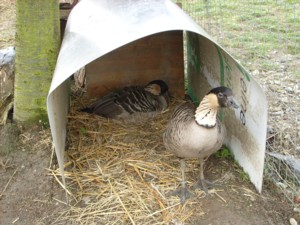Breeding:
Generally I prefer natural hatching, but it is not always possible.
For geese Natural hatching is the best way and the most recommended, because
most of them are able to defend their nests against predators or conspecies.
Most geese are ground-breeders and my species build their nests in places specifically
set for that purpose.
 |
 |
|
|
|
On the first days after the goslings are hatched out I keep them together with their parents
in a separate enclosure so they learn to peck feed pellets and not only eat grass.
Some days later they are free to roam in the whole area.
 |
 |
|
|
|
Some species of geese, especially the goslings, are very vulnerable to parasites.
So I take care that goslings are timely dewormed.
Generally the breeding of geese is not very demanding or difficult.
.
Breeding of ducks:
To avoid losing eggs to martens, polecats, hedgehogs, crows, magpies or even woodpeckers,
I exchange the laid eggs for plaster or bantam eggs every day. Some days later,
when the female duck starts brooding and if I can expect undisturbed brooding (at most of the cavity breeders),
I put back the collected eggs. If I cannot expect undisturbed brooding, I have the eggs brooded
by mallards or bantams in a dry stable.
 |
 |
|
|
|
Within the first 12-24 hours after the ducklings are hatched, they are set into an outdoor enclosure
together with their mother or “stepmother” (mallard duck or bantam). I generally try to avoid
rearing ducklings in boxes with infrared lamp.
The enclosure includes a small plastic pond and a box, which can be closed during the first nights
for protection against nightly predators and bad weather.
 |
 |
|
|
|
The first feeding of the ducklings is offered on water. So they learn early on to take the feed.
After about one week they only get dry feed.
After 4 weeks the ducklings are separated from their mother and set into a bigger enclosure
with an aluminium pond where they grow up with other ducklings of the same age.
 |
 |
|
|